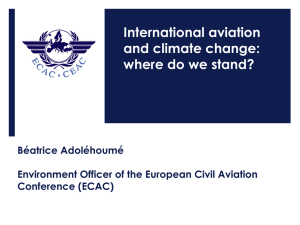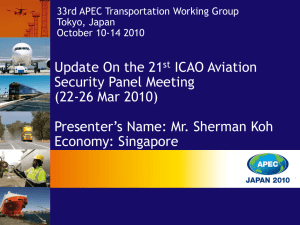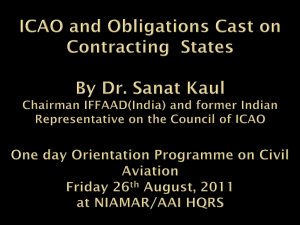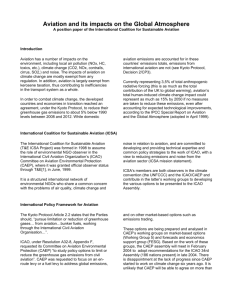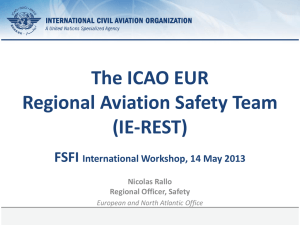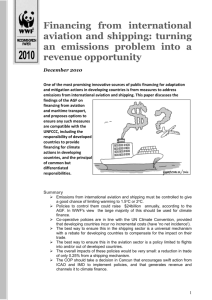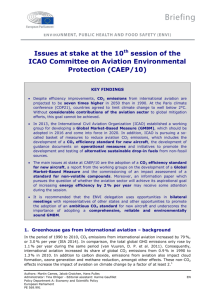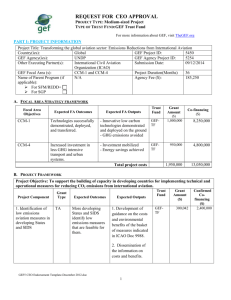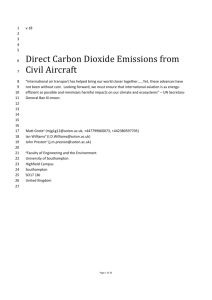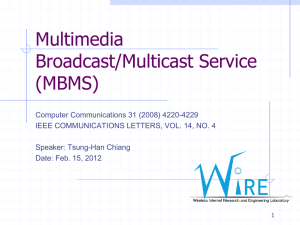Mitigating Emissions from International Aviation
advertisement
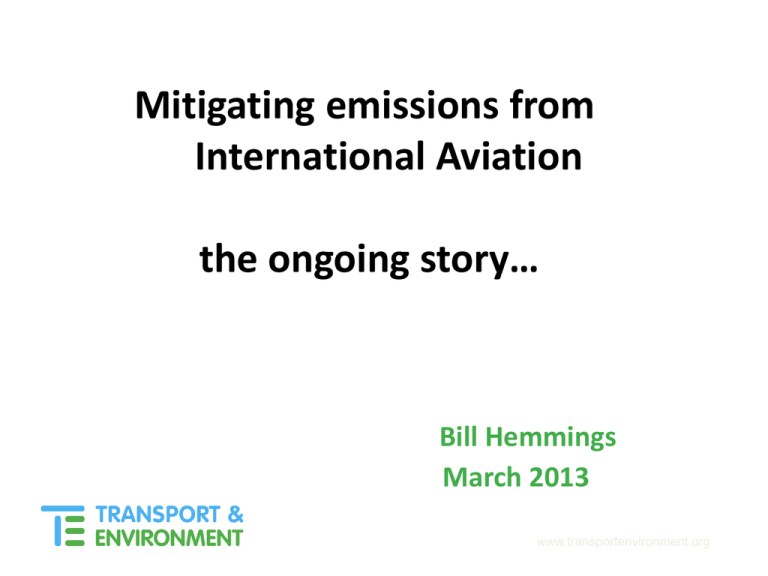
Mitigating emissions from
International Aviation
the ongoing story…
Bill Hemmings
March 2013
www.transportenvironment.org
Transport
Transport &
& Environment
Environment
• Brussels based European Federation
• Founding member of International Coalition for
Sustainable Aviation – ICSA – the NGO
Observers at ICAO since 1999
• participants in ICAO CO2 WG developing ICAO
CO2 standard for new aircraft
• ICSA participant in 2012 ICAO WG on MBMs
• we also do cars, vans, trucks, traffic noise,
biofuels, air quality, shipping.
www.transportenvironment.org
ICAO work on technical and political issues
•1998-2010 – ICAO CAEP work into open and closed
trading systems; taxes, charges; offsets, voluntary initiatives
• 2004 Assembly agrees no global scheme but recommends
national/regional emissions trading
• 2007 mutual agreement reaction to EU ETS
• 2008 guidance on implementing emissions trading
• 2008-2009 – GIACC failed to agree on a plan of action
• 2009 High Level Meeting on Climate Change;
Declaration on design of MBMs; “Basket of Measures”
• 2010 Agreed to pursue CO2 standard for new aircraft and
new noise standard – Chapter 14 in 2017
www.transportenvironment.org
ICAO 37th Assembly Resolution 2010
• Discussion on climate change – no consensus on action
• 2% global annual fuel efficiency improvement goal until 2020
- and an aspirational goal of 2% p.a. 2021 to 2050
• set medium-term aspirational goal; keep the global net carbon
emissions from int. aviation from 2020 at the same level;
- ie 2020 CNG
• Develop State Action Plans
• Adopted principles for MBMs
• Set de minimis threshold of 1% RTK international activity
• operators MBM exempt and States from Action Plans
www.transportenvironment.org
Current ICAO work
The 37th Assembly Resolution requested the Council to:
• review the 1% global RTK de minimis threshold;
• develop Framework for market-based measures (MBMs)
• explore feasibility of a global MBM scheme, study technical
aspects, environmental benefits, economic impacts,
•late 2011 Sec Gen call to agree global MBM by end 2012
•Group of Experts established January 2012
•Three options for MBMs - full access to carbon markets.
- offsetting
- offsetting plus a revenue generation mechanism
- cap and trade emissions trading system
•Nov 2012 Council from High Level Group HGCC
EU Stopped Clock for ICAO agreement
•
•
•
•
•
Enforcement of extra EU flights suspended until Jan 2014
EU ETS returns Jan 2014 unless changed beforehand
EU will modify if ICAO reaches Assembly global agreement
MEPs say will only amend ETS if ICAO makes real progress
Options for yearend;
– Full reinstatement
– Outbound flights only; or 50/50
– Airspace or FIR
– Extend stop the clock – hard sell in EU Parliament
– Full suspension - hard sell in EU Parliament
www.transportenvironment.org
The ICAO battleground
Equal
treatment
(ICAO)
Common But
Differentiated
Responsibilities
(UNFCCC)
Departing
Flights
Airspace
Assumed
Consent
Mutual
Agreement
Emissions
Trading
Offsetting
Targets
Aspirational
goals
7
versus
High Level Group Aviation Climate Change HGCC
Advise on developing a global MBM
Advise on developing the MBM Framework
Discuss basket of measures – US insisted
3 meetings – thats been enough
dissension on global – India, China no responsibility to act
- MBMs voluntary
•EU; realistic date for finalising a global MBM could be 2015
•others incl US not specific – delay
•Very little support for revenue generating option
•No discussion on targets, options, allocation
•worryingly little progress
www.transportenvironment.org
Framework for MBM
• US declared support for airspace based
– already provided for in Chicago
•
•
•
•
•
•
•
most other countries agreed
except Australia, Canada,{Gulf States}
US; no need mutual agreement if Framework
but airspace no safe haven
India et al; all MBMs voluntary; mutual agreement
might accept airspace over arriving country only
airspace reduces EU ETS by 84%
www.transportenvironment.org
ICAO; what next?
HGCC Report sidelined as info paper
Secretariat/Council will draft Assembly resolutions
ATC and Council now; Consultations over the summer
Special (Council?) meeting early September
IATA AGM calls for agreement on MBMs at this Assembly
China et al dismiss this at ATC
Key issues;
Agree on global MBM in 2013 to implement in 2016
CBDR – Council has dismissed de minimis proposal
how to treat fast growth carriers fairly.
how can a program based on offsets be environmentally sound?
How to implement globally without new Treaty?
Problem at ICAO; there is an “emissions gap”
PROBLEM: ”None of the [emissions reduction] measures, or their combinations, for any growth
scenario managed to meet ICAO’s aspirational 2020 carbon-neutral goal by 2050, the 2005
stabilization of emissions goal, or the 2005-10% stabilization of emissions goal. The 2% goal
would only just be met by 2050, through assuming maximum reductions from technology,
operations, and “speculative” availability of biofuels.”
Source: Lee. et al. 2013 “Bridging the aviation CO2 emissions gap: why emissions trading is needed”
IATA’s Credibility Gap
www.transportenvironment.org
ICAO to UNFCCC Bonn
www.transportenvironment.org
Aviation and shipping in a 2oC context
Source: Shipping and aviation emissions in the context of a 2°C emission pathway, David
S. Lee et al (MMU), March 2013
14
CO2 emissions from
developed and developing States
Source: Peters et al. 2012, Nature
Historical responsibility in aviation
China IACO State Action Plan Aviation wasn’t around in 1850
“International air transport in
developed states enjoys a
longer history, a larger marketshare worldwide and stable
growth. Due to the historical
contribution of their
international aviation to global
climate change, developed
countries must shoulder their
responsibility for their
accumulative historical
emissions and the current high
level of per capita emissions”
Top historical emitters from 1850
include China, India, Brazil, South Africa
Top 20 historical aviation emitters;
China, Singapore, R Korea, UAE,
Thailand, Malaysia, Brazil
first flight 1903. first airline KLM 1919
First large jet Boeing 707 1960
first intercon Jet Boeing 747 1970
mass airtravel only took off in 1970
no country emissions data before 1990
ICAO 2010 RTK by country 1974-2009
Cum Int RTK 1974-2009
1USA
2UK
3Germany
4Japan
5France
6China
7Singapore
8Netherlands
9R of Korea
10Australia
11Canada
12United Arab Emirates
13Thailand
14Italy
15Switzerland
16Spain
17Malaysia
18Russian Fed
19Brazil
20Scandinavia
% Total
17.04%
8.29%
6.72%
5.67%
5.04%
4.40%
4.23%
4.07%
4.05%
2.55%
2.24%
1.92%
1.85%
1.81%
1.64%
1.61%
1.45%
1.23%
1.19%
www.transportenvironment.org
1.09%
Cumulative International Aviation Traffic
(1974 to 2009 RTK)
developing
33%
developed
67%
www.transportenvironment.org
Cumulative International Aviation Traffic (1974
to 2009 RTK) by region
www.transportenvironment.org
Int Domestic and International Fuel Burn
2010
285,66 Mt CO2
(38,6%)
455,32 Mt CO2
(61,4%)
Domestic traffic
International traffic
Global Aviation Emissions 2010 by region
180
Aircraft fuel burn (Mt CO2)
160
140
120
100
Domestic traffic
80
60
40
20
0
International traffic
Fuel Burn by Region; 2010
100%
Percentage Aircraft fuel
burn
90%
80%
70%
60%
50%
40%
30%
20%
10%
0%
Americas
Asia Oceania
Europe
Africa
Middle East
Cumulative fuel burn by region
2020 to 2050
Latam.
7%
Africa
6%
Middle East
9%
Asia/Pacific
36%
North
America
13%
Europe
29%
www.transportenvironment.org
